MODERNISING MINING TECHNOLOGY AND EQUIPMENT
November 4, 2016
It’s tough to stay relevant in the mining industry when once reliable mechanical systems no longer function well enough to yield healthy profit margins. The cause of the falloff is related to several factors, including that inaccessibility factor that’s troubling so many established extractive enterprises. Predictably, the mining sector is undergoing a transition phase so that these obstacles can be managed. It begins with an equipment modernization strategy, an extractive renaissance that’s transforming the mining frontier.
MODERNIZING MINING EQUIPMENT
An incremental overhaul strategy is injecting outmoded gear with new features. On the surface, there are easily discernible changes. These are the driverless trucks on rails and the remote controlled equipment that strengthen two-kilometre deep processes, but the technology is also reinforcing contemporary systems. Screening technology, for example, uses exactingly fabricated thermoplastics to absorb the impact of high-volume aggregate streams, but the mechanism is still evolving.
FORTIFIED BY TECHNOLOGY
The evolution of screen equipment calls upon new sensory apparatus and separation systems. Laser-assisted instruments are the eyes of this innovative particle-analyzing configuration. Meanwhile, reciprocating motors are getting a leg up by employing magnetic separation technology, a cleverly aligned series of electrostatically induced fields that can easily manipulate charged particles. Importantly, this technology is not designed to replace oscillating motors and screen media. Instead, they’re exploiting well-understood engineering principles so that existing equipment can smoothly transition into the technological age.
CREATING AN OBJECTIVE EXTRACTIVE ENVIRONMENT
Mechanized efficiency epitomizes the crux of the matter, but there are other factors that require deliberation. One example of this design philosophy is the need to assess ecological issues before implementing a solution that’s based on productivity-assured improvements. Basically, new features must be energy-efficient and not energy-antagonistic. That means the new multi-functional equipment covered here should be assessed for power efficiency before it can be integrated as a core operating part of a modernized system. Of course, technological solutions aren’t limited to new functions. The renaissance period is also producing superior adaptive materials. They’re synthetic substitutes that can be tailored for any purpose. Engineering plastics represent the customized power behind this advanced material asset.
The topmost layer of the new technologically-induced infrastructure is created from data packets and analytical software. Built to address productivity issues, information technology measures everything with newly installed lasers and sensors, but it’s the newly designed equipment that then potently applies mining technology directly to the extractive setup. Efficient new conveyor systems, screens, crushers, and aggregate processing machines enable this modernized setup to properly prosper.
Optimized by: Netwizard SEO


